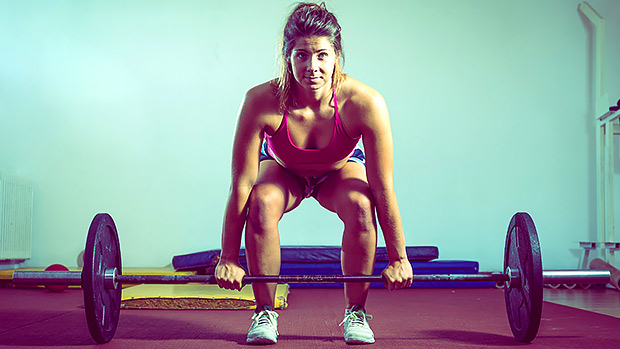On paper, the deadlift is about as straightforward as it gets: Pick the bar up and put it back down. But don't judge a book by its cover, because the deadlift comes loaded with nuances. Here are two common deadlift mistakes:
- Not pushing your hips back.
- Not using your lats to keep the bar close.
Let's fix those problems with these drills.
This helps you initiate the deadlift with your hips. Your hips travel horizontally during deadlifts (back and forth), as opposed to vertically during squats (up and down).
Many lifters initiate the deadlift by pushing their knees forward instead of pushing their hips back. This isn't an ideal set-up because:
- There's too much weight on the front of your feet. You want to have your feet rooted to the floor so you're able to maintain a "heavy heel." By pushing through the floor with your whole foot instead of just the front, you're able to engage the glutes more effectively.
- There's no space for the bar to travel up. If you descend into your deadlift by first pushing your knees forward, it doesn't leave much room for the bar to come back up in a linear fashion. Beginning your set-up and eccentric phase by pushing your hips back keeps your shins slightly more vertical and allows the bar to travel up in a straight line without hitting your knees.
- Your hips aren't set. Pushing your knees forward excessively during the deadlift set-up usually results in your hips coming forward as well with a hyperextended lower back. Pushing your hips back first will set them in an optimal bottom position with a neutral lower back.
How to Do It
- Use a kettlebell or barbell.
- Loop a band around a squat rig and place the band around your hips.
- Step forward so the band is pulling you back slightly.
- Get into your preferred stance (sumo or conventional).
- Start your set by letting the band pull your hips back. Naturally, your knees will bend as you hinge forward.
- Hold the bottom position for a 2-3 second count so you can get a feel for it.
- Push the floor away from you as you come back up (applying force through the ground).
- Push your hips forward until they're fully extended and squeeze your glutes.
This one helps teach you to keep the bar close and engage your lats.
Every compound lift incorporates both primary and secondary supporters to perform optimally. During deadlifts, one of the primary supporters are the lats. They allow you to maintain close contact with the bar throughout your deadlift.
One of the biggest issues (and biggest reasons chiros have thriving businesses) is letting the bar drift away from your body. The further away you are from the bar, the shittier it is for your spine. If you like lifting and want to continue doing it, you don't want that to happen.
The best, strongest deadlifts are when you keep the bar as close to your body as possible. This drill teaches you to keep the bar close to your body and maintain lat engagement.
How To Do It
- Stand in the center of the rig holding a barbell.
- Press the barbell back against the columns of the rig and squeeze your armpits together to feel tension in your lats.
- Push your hips back and hinge over into your deadlift. Keep the bar pressed back against the rack.
- Come back up and push your hips forward while maintaining constant contact between the barbell and the rack. It should glide against the rack as if you're simulating a Smith machine.





